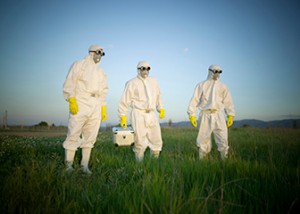 With the goal of cleaning up materials that could potentially harm people or our environment, a hazardous material removal worker is responsible for identifying and disposing of materials that are toxic, flammable, radioactive, or corrosive. As the number of abandoned hazmat sites recognized by the Environmental Protection Agency (EPA) continues to grow, so does the demand for hazardous material removal workers to clean up facilities, store waste, and decontaminate equipment safely. In fact, the employment of hazardous material removal workers is expected to grow at the fast rate of 14%, thus creating 5,300 new jobs within just eight years, according to the Bureau of Labor Statistics. In order to determine if this is the right career path for you, the following is a full job description of a hazardous material removal worker.
With the goal of cleaning up materials that could potentially harm people or our environment, a hazardous material removal worker is responsible for identifying and disposing of materials that are toxic, flammable, radioactive, or corrosive. As the number of abandoned hazmat sites recognized by the Environmental Protection Agency (EPA) continues to grow, so does the demand for hazardous material removal workers to clean up facilities, store waste, and decontaminate equipment safely. In fact, the employment of hazardous material removal workers is expected to grow at the fast rate of 14%, thus creating 5,300 new jobs within just eight years, according to the Bureau of Labor Statistics. In order to determine if this is the right career path for you, the following is a full job description of a hazardous material removal worker.
What Hazardous Material Removal Workers Do
While working in small teams, hazardous material removal workers follow strict guidelines to neutralize the potentially harmful risks presented by asbestos, nuclear waste, arsenic, lead, mold, radiation, and other hazardous materials. On a typical workday, hazmat removal workers often are involved in cleaning up liquid spills with absorbents, ensuring compliance with laws on waste disposal, testing hazardous materials, constructing containment areas, cleaning contaminated equipment, recycling waste, packaging hazardous materials, and maintaining detail records of all cleanup activities. Some hazardous material removal workers specialize their services in cleaning up harmful materials in response to natural or man-made disasters in emergency management to prevent more damage to accident sites.
Where Hazardous Material Removal Workers Work
According to the Bureau of Labor Statistics, around 37,500 hazardous material removal workers are employed throughout the United States, with an estimated 77% working in the waste management and remediation services industry. Hazmat removal workers can find plentiful job opportunities cleaning up hazardous materials in office buildings, schools, hospitals, landfills, incinerators, industrial furnaces, nuclear facilities, electric power plants, and historic buildings. Since removing hazardous materials is extremely dangerous, workers are required to wear coveralls, gloves, safety goggles, shoe covers, and often respirators while working to reduce potential exposure. Most hazardous material removal workers are employed full-time, but many work long overtime or night shift hours when employed in emergency response.
How to Become a Hazardous Material Removal Worker
While all hazmat removal workers need at least a high school diploma for employment, some choose to receive an associate’s degree related to radiation protection or emergency management to increase job prospects in nuclear facilities. Rather than high education, hazardous material removal workers receive up to 40 hours of intensive on-the-job training in compliance with the Occupational Safety and Health Administration’s standards. Through a combination of classroom learning and field instruction, the training will teach workers on safety procedures, equipment, chemicals, personal protective gear, and decontamination techniques. Some states also require hazmat removal workers to become licensed by passing a written examination, especially for mold remediation and asbestos or lead removal.
Related Resource: Toxicologist
Overall, hazardous material removal workers are hard-working individuals who are given the hefty responsibility of cleaning up any harmful materials that could potentially cause danger to people, animals, plant life, and our environment at large. If you believe you have the decision-making skills, attention to detail, mechanical abilities, and physical stamina to take on this career path, it is highly recommended that you consider becoming a hazardous material removal worker to make your mark on protecting the planet from dangerous toxins.